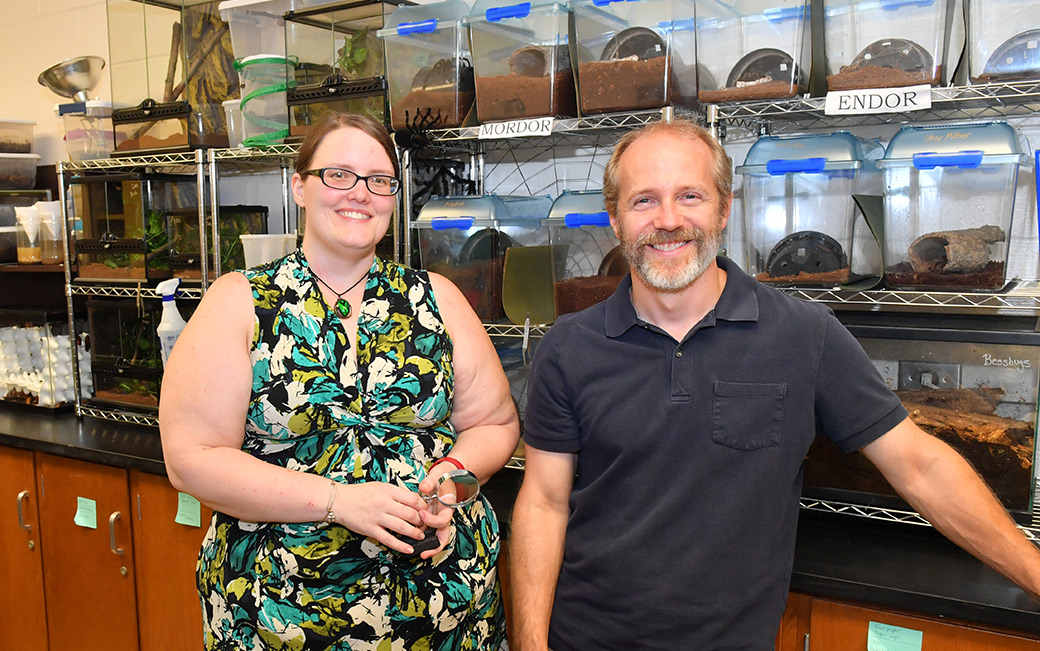
Bug research funded; Professors receive grant to continue project
By Anthony Petro, Staff Writer
Photo Courtesy of Towson University
Towson University’s Fisher College of Science and Mathematics recently received a more than $730,000 grant to study the relationship between two small bugs from the National Science Foundation.
Professor John LaPolla, who teaches entomology courses at Towson, and his team received the grant for their research about Acropyga ants and their symbiotic relationship with mealybugs. This was LaPolla’s third attempt at receiving the grant.
LaPolla describes the relationship between the Acropyga and mealybugs as “dairy farming.” The ants are like farmers while the mealybugs are like the cows.
“The mealybugs secrete honeydew and this is the ant’s sole food source,” LaPolla said. “These ants live solely underground and they will put the mealybugs on plant roots and then eat the nutrients the mealy bugs secrete. The queen Acropyga even carries a mealybug with her when she starts a new colony.”
The ants and mealybugs have been living together with this mutualistic relationship for over 30 million years.
“The question we are hoping to answer, now with the help from the grant money, is how this relationship has lasted so long and what it could mean for human evolution and future human agriculture,” LaPolla said.
Professor Faith Weeks, who teaches science for elementary majors, TU alum and USDA research entomologist Scott Scheider, chair of the Department of Entomology at the Smithsonian Institution National Museum of History Sean Brady, graduate student Aaron Robinson and undergraduate student Paul Umemezie were all part of LaPolla’s team.
“I was surprised but really happy when I found out we got the grant,” Weeks said. “Not a lot of organizations have that kind of money to grant to projects like this.”
Weeks is in charge of making the research more accessible to the public and turning the research into a teaching tool for K-12 science teachers.
“It’s public money, the information should have public impact,” Weeks said. “My job is to educate the public about what the scientists are doing. If we don’t share the research, then what’s the point?”
Weeks hopes to translate the research into part of science curriculums where the students get to see real research and its real-world applications.
“I hope showing people this research will give them a better understanding that insects are an important part of the ecosystem,” Weeks said. “We see symbiotic relationships everywhere.”
She also hopes these teachings will help change the public stereotype of scientists.
“When you think of scientists you picture some old guy with crazy gray hair wearing a lab coat and holding a smoking beaker,” Weeks said. “Well, almost none of us are like that, and the public needs to see that. Hopefully through these teachings they can.”
LaPolla and Weeks both highlighted the importance of using this research and the grant money to help undergraduate and graduate students get experience.
“The grant is on the larger side for this field,” LaPolla said. “The money, for three years, will provide us to pay the graduate and undergraduates who help us. It also allows us to provide post-doctorate fellows with experience at the Smithsonian as well as actual teaching experience.”
Robinson is researching the head and mouth shapes of the Acropyga.
“Aaron is looking at how the Acropyga head shape has changed and why they are not all similar, like all other ant species,” LaPolla said. “Through his research we might be able to correlate head and mandible shape to the shape of the mealybugs which could imply they influence each other’s evolution.”
Robinson said his time working on the project with LaPolla has been invaluable.
“I’m really happy to be a part of this, and I get out of having to be a TA,” Robinson said. “I’ve gotten to meet and network with people at the Smithsonian and other entomologists and pharmacologists. Not to mention I got to go to South Africa to study these ants directly.”
LaPolla, Weeks and Robinson hope they can put this huge grant to good use in the next few years and show the world that the Acropyga have a bigger role outside of the world of insects.

